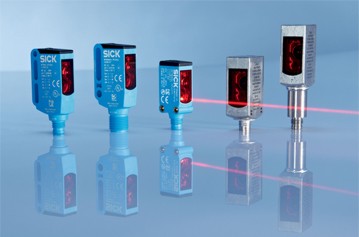 Sick Sensors > Sicks high quality optical displacement sensors
Sick Sensors > Sicks high quality optical displacement sensors
Sicks David Hannaby, product manager states that: Quality assurance (QA) requirements in the manufacturing sector has completely changed in the last twenty years.
Goods are normally produced to sub-micron or micron tolerances therefore they need to constantly be measured without actual contact.
The straightforward photo electric detection of whether a part is present or not, is not enough anymore and QA need to know the exact variation of the position of a part in assembly.
Requiring more precise variation therefore has led to the creation of a huge range of optical displacement sensors which give analogue outputs that determine the space in-between target and sensor. Most optical distance measurement systems use Class II or class I lasers for their source of light, instead of LED or infra red which have been used previously. Recently the lasers service lives have improved greatly and their usually low wattage has made them safe to be used in both QA and manufacturing. The newest development in short-range distance measurement is the optical displacement sensor, which is now common place in QA techniques to establish positions, dimensions as well as quantifying characteristics for example deformation, vibration and curvature. Making use of optical displacement sensors as they are now seen as high quality therefore delivering advantages within the following industries: packaging, automotive, tooling machining and robotics.
Normally optical displacement sensors are a far better option than Linear Variable Distance Transducer probes as they are very practical and cheaper when moving of the probes would be needed. Linear Variable Distance Transducer probes must be touching the product that is being examined, therefore it could damage the goods or the probes. Whereas optical displacement sensors do not need to be touching therefore they have been identified as being as precise as Linear Variable Distance Transducer measurement. Optical displacement sensors can be purchased as individual sensor systems or self-contained units, where numerous single sensors interface with a common controller. The sensor system provides lots of advantages due to its simple program controller, therefore making is feasible to set output functions, specify requirement and implement filters, which is cheaper than employing a programmable logic controller. If you have a few sensors then you can collect information from them as a group by applying formulas.
Recently Sick provided optical displacement sensors which are required for important QA practices in smartphone screen manufacture. Tablet and smartphone touch screens have lots of layers of transparent materials. Therefore the construction has to be accurate, as errors or imperfections can lead to breaks. To stop this happening it is vital to examine the width of the glass. The size of the gap between sheets of glass for example. The most recent sick optical displacement short range distance sensor calculates glass width, as well as the distance between a couple of see-through components, with a single sensor head. This can be utilized to calculate the coplanarity of parts, i.e casing and displays of tablets, hard disk drives or smart phones. The principle called laser triangulation, along with metal-oxide semiconductor receiver technology, allows the width of the glass to be calculated of glass thickened with a single sensor head. The sick OD Precision short range distance sensor identifies the positional coordinates on the top of the glass as well as the opposite side automatically and therefore outputs contrast between them. The identical output-rate, measures both precision and consistency and they are accomplished with normal distance measurement. You can even calculate the gap between other materials and glass.
If you are specifying the ideal distance measurement sensor for a job, It is vital to take into account several things as well as the distance between the target and the sensor. Important factors include accuracy, resolutions and repeatability. It is vital that you know what each one means before you talk to your supplier:
Resolution: Resolution is the lowest measurement that the sensor can measure. I.E If the sensor features a specific resolution of ten millimetres the following measurement in the scale would be twenty millimetres, then thirty millimetres etc.
Repeatability: This signifies the difference in between several measurements of the identical parameter which is carried out under exactly the same conditions. If a sensor transmits and measures an analogue value each millisecond, the values will be much the same therefore repeatability is good. Present optical displacement sensors in the sick short measuring ranges achieve repeatability of 0.6 micron.
Accuracy: Is the highest measuring error between the determined and also the actual distance- which is defined as a % of the full-scale measuring range. If a sensor is said to have precision of 1% of the complete scale along with the sensor having a full scale of twenty mm, the accuracy would therefore be 0.2 millimetres. Additionally it is essential to think about reaction time as well as output type. Analogue outputs of four-twenty mA current or 0-10 VDC voltage permits simple modification to process variables and tolerances. For an effective requirement it is ideal to work with your sensor supplier who could guarantee efficient commissioning and installation.
Advantages of the optical displacement sensors:
- High quality products.
- The sensor does not touch the product
- Can detect between the target and the sensor
- Service lives are greatly improved
- Safe to be used in both manufacturing and Quality Assurance
- You can collect information in groups.
For more information on any of the entire Sick sensors range contact us at Electroquip today.
